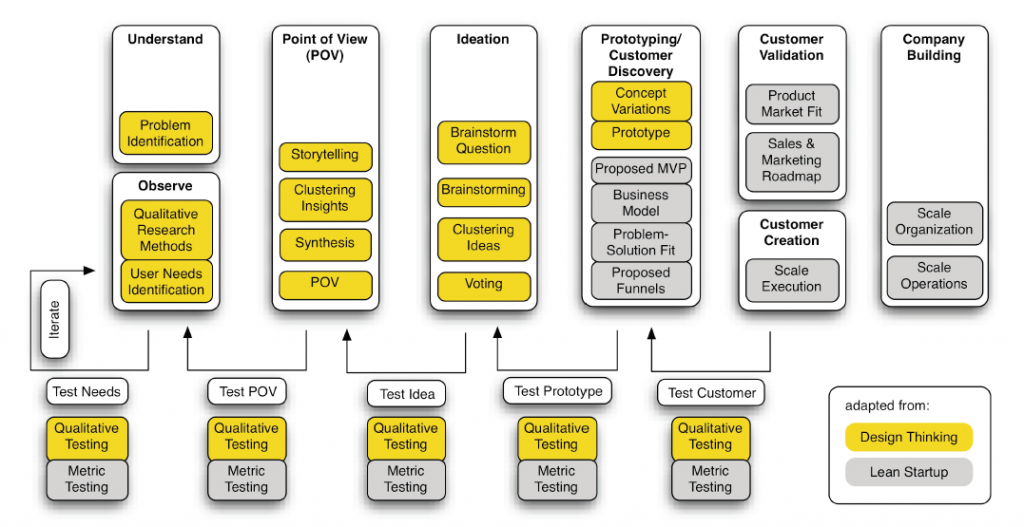Both Lean Startup and Design Thinking are promising approaches in order to target innovation. The Lean Startup concept is an appropriate choice for creating new businesses through development of an already existing idea or vision. Design thinking, on the other hand, might be preferred if the right business idea has not been found yet and customer needs or problems are still vague.
Therefore, both approaches should be capable of complementing and benefiting from each other. An interesting paper from Roland M. Mueller and Katja Thoring discusses the integration of both approaches, resulting in a combined process model. The authors highlight the following potentials to improve either of the two innovation concepts:
Potential to improve Design Thinking
There is potential to improve the design thinking process by converging the two strategies in terms of the iteration. Pivoting as it is practiced in lean startup seems to be a promising opportunity to strengthen the design thinking process. This means to implement feedback testing and iteration loops earlier in the process, even before there is a prototype. This could happen for example after the Point of View or after Ideation. The testing of early problem hypotheses, that can be falsified or validated, might save time and resources, and could result in a better output of successful project results. Moreover, it is suggested to implement metric-based evaluation techniques as they are commonly used in lean startup. For example, testing in design thinking is mostly performed qualitatively in the analyzed literature. Therefore, checklists or specific test environments that allow for quantitative measuring of user feedback (such as landing page design, smoketest, etc.) should be implemented in the design thinking process. Also, it is suggested to develop a business model in addition to the prototype, to validate the viability of the concept.
Potential to improve Lean Startup
Unlike design thinking, lean startup does not describe specifically how customer input could be collected. Qualitative research methods—e.g. ethnographic methods—could be applied to improve the definition of the targeted customers and to identify their needs and problems. Similarly, we suggest adapting the synthesis methods from design thinking. Structured frameworks or the generation of a qualitative persona might help lean startup to better understand and develop their customers and their respective needs and problems. Both should be scheduled at the beginning of the process. Lean startup could also benefit from the use of ideation techniques, as they are applied in design thinking, to develop concept variations. Although lean startup usually starts with a concrete business idea, it might be helpful to use structured ideation methods to iterate that idea within the process, specifically before the problem-solution fit is achieved. Consequently, pivoting should be applied earlier (already on the initial concept). And finally, qualitative feedback evaluation, such as qualitative user interviews, could be implemented in the pivoting steps, in addition to the metric-based evaluation techniques.
The resulting process model is called “Lean Design Thinking” and integrates the most promising features of both approaches. I think it’s a useful attempt to merge these increasingly upcoming frameworks. The Lean Design Thinking process may help to explore entirely novel innovation opportunities – where both market/customer needs as well as solutions are unknown at the outset – while staying customer-centered all along. If we ensure a match between what the market needs and what we are offering, there is a good chance our innovation is going to succeed.
For further details, I recommend reading the entire paper:
Robert M. Mueller and Katja Thoring: Design Thinking Vs. Lean Startup: A Comparison Of Two User-Driven Innovation Strategies, 2012 International Design Management Research Conference

8 Responses to Integrating Lean Startup and Design Thinking